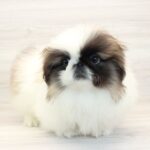Whether you’re looking for English Cream, Piebald, Black, Blue and Tan, or any other rare color of the dachshund, you’ve probably come across a few misnomers about these canines. While some of these colors are truly exceptional, some are just as rare as the other popular colors. Listed below are the most popular colors and descriptions. Keep reading to find out the details about these gorgeous dachshunds!
English Cream
The English Cream Dachshund is a unique color that is not widely available. The coat color of these breeds is not usually seen outside of the UK. They are sweet and affectionate and are often seen as family pets. Their loyality and affection for their owners is a characteristic that sets them apart from other dachshund breeds. However, English Cream Dachshunds are not suitable for everyone, as they can be temperamentally challenging.
The EE Cream Dachshund has a color that is associated with the “EE-red” gene, which inhibits the production of the dark pigment. Because of this genetic trait, an English Cream Dachshund is born with a creamy-colored coat, paw pads, and whiskers. However, a Shaded English Cream Dachshund has darker fur, dark whiskers, and a black nose.
The English Cream Dachshund is one of the most desirable types of Doxies. This color is rare and coveted, so it’s important to buy a puppy from a reputable breeder. The English Cream Dachshund has the same physical features as a regular Doxie but has a rich cream coat that is similar to an eggshell. This color is so rare that its owner may not have one available for sale.
The English Cream Dachshund has a sensitive skin and a tendency to become obese. Combined with conditions that affect motility, English Creams can become obese and develop a range of health problems. They are particularly susceptible to skin cancer, hemangiosarcomas, and tumors of the reproductive system. You should be aware of the health risks associated with this breed and avoid them at all costs.
Piebald
If you’re looking to add an eye-catching color to your dog’s coat, look no further than the Piebald Dachshund. This breed has a colorful history in Europe, and is highly regarded by dog enthusiasts for its distinct markings and unique personality. See them prancing around show rings, strolling along with their masters down city streets, or rolling through dog parks – these stunning creatures have captured the attention of show judges and loving pet owners alike.
A Piebald dachshund’s coat is defined by large patches of white over its base color. These patches may have black ticking or dappled accents. These puppies usually have blue eyes. Breeders should take special care when breeding two Dapples, as the offspring can develop severe health problems and heartbreaking birth defects. Piebald dachshunds may also sport ticking on their white areas.
The Piebald color is the most rare and striking of all. It is caused by a gene that affects eumelanin in the dog’s coat, which gives them a distinctive appearance. Piebald dachshunds have a brown to gray base coat that has a predictable pattern. Dapple dachshunds are lighter in color and may even have flecks of pink or blue.
While most Dachshund color variations are not rare, they may be dangerous for your dog. The diluted colors can lead to skin infections, cancer, and hair loss. In addition to Piebald, Dachshunds can have a dapple, sable, or brindle pattern. A Piebald Dachshund is a rare example of a Dachshund with a diluted color gene.
Blue and Tan
The most common Dachshund colors are red and white, but there are also some rare color variations. Some are solid black, and some have tan highlights. A black Dachshund is not considered a standard AKC color, and is likely from a puppy mill. However, it is possible to get an all-white or all-chocolate Dachshund, and these are not common colors.
Another common color combination is blue and tan. This color combination is considered rare, and it’s not as common as some other colors. However, blue and tan dachshunds can be found in some breeders. Blue and tan dogs have a high demand among dachshund owners, and are coveted for their rarity and beauty. Breeders often take advantage of the rarity of these colors by charging ridiculous prices for unhealthy pups.
Blue and tan dachshunds are more common in Australia and Europe. These dogs are not as common as the other two colors, but there are a few examples of them. Tan Dachshunds have the same tan patches as the Black and tan dachshunds. While tan and blue Dachshunds have blue hair, chocolate and cream dachshunds have cream coloring.
In addition to Blue and tan, the other colors that are uncommon in the Dachshund breed are Dapple, Piebald, and Blue. Each of these colors has its own unique set of health problems. Blue Dachshunds are prone to skin allergies and sunburn, and have a much lower lifespan than other Doxies. Blue Dachshunds can also develop a fatal gene, so be aware of this before breeding.
Black
There are a wide variety of colors and markings among Dachshunds, and different breeds can be born with varying combinations of these shades. Different markings can be found on the head, feet, and paws, as well. Some of these colors and markings are rare and may be caused by recessive genes, while others are a result of unethical breeding practices. Here are some common colors of Dachshunds.
Double marble dachshunds have white spots over different shades of black. Some dogs have a single black spot on their body, while others have several dark spots over a different color. They may have blue eyes. These rare dachshund colors can be dangerous, since they are susceptible to deafness and blindness. Breeders of these dachshunds should take special care to avoid breeding them.
The color of a Dachshund depends on the breed. Pure black dachshunds are the most desirable because they are completely black. However, pure black dachshunds are extremely rare. Most are born with some tan markings. Another rare Dachshund color is wheaton. This color is similar to an English cream, but is slightly darker. All coat types of these dogs are available.
Another color found in these dogs is wheaten. This color is rarely seen due to the lack of pigmentation in their skin. Albino dachshunds are usually blind or deaf, and can only be bred if they are not white. Blue doxies are not like the Isabella doxies. Blue doxies have a light blue color in their coat, but they always have tan points.
Double dapple
The dappled coat of a dachshund varies, but it is most often white with random patches of other colors. These markings may include white paw pads, noses, tail tips, and bellies. In some cases, the dog may even be completely white. If this is the case, the dog will have blue eyes. A double dapple may also have merle patches on its torso.
A dappled coat is the result of dilution of two pigments in a dog’s coat. Although dappled dogs have large patches of different colors, these are usually very small. A double dapple dog will have multiple patches and a mixture of colors. However, it is not recommended to breed two dappled dogs with each other, since this could result in health issues.
Due to the dappled coat, a double Dachshund may have either normal or light eyes. The lack of pigment may result in deformed eyes, missing eyes, or blindness. Double dapple Dachshunds are extremely unique, but if you are considering a dachshund as a pet, you may want to consider genetic testing first. Breeding a dappled dog with a chromosome variant is unethical and results in a dog with health issues.
The dappled dog has stripes of gray or black over a base color of dark red or brown. The spots should be small and irregular and have a neutral color. Large spots are not acceptable. The dappled pattern may be in any color but grey or beige is the preferred choice. This type of coat can be registered with any major kennel club. You can also choose a dog with a dappled pattern of different colors.






